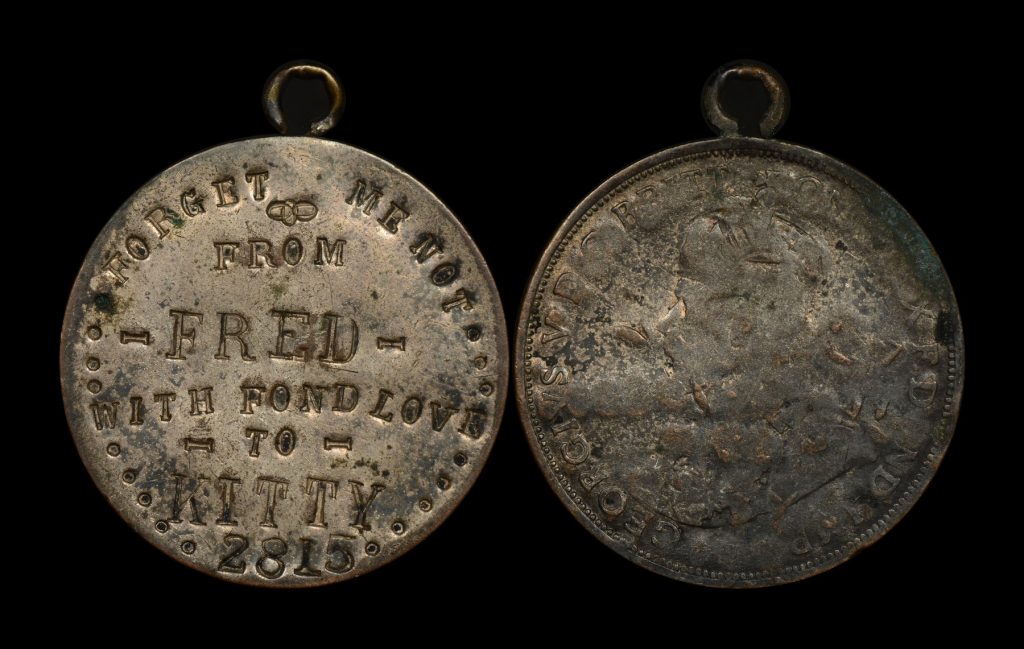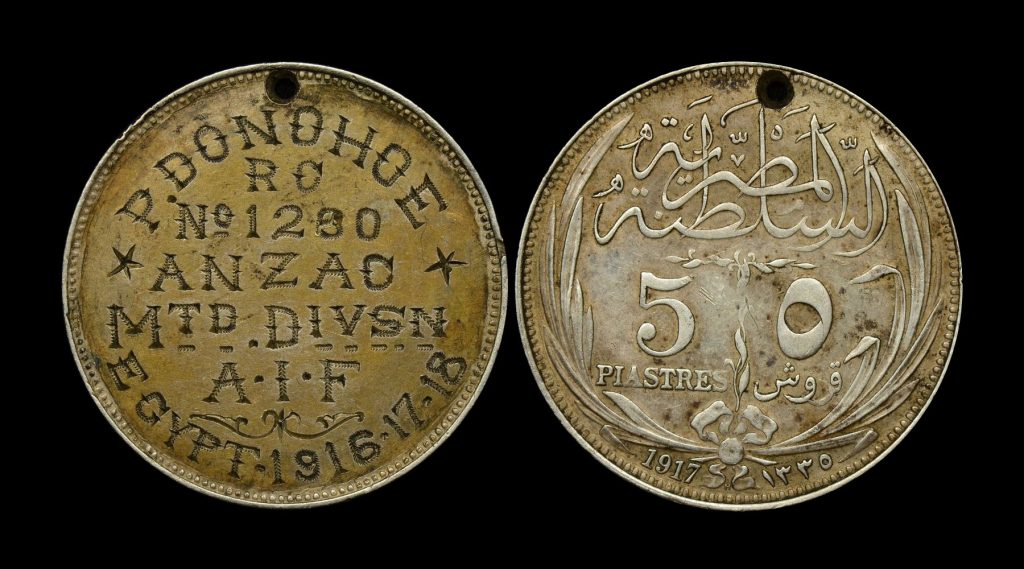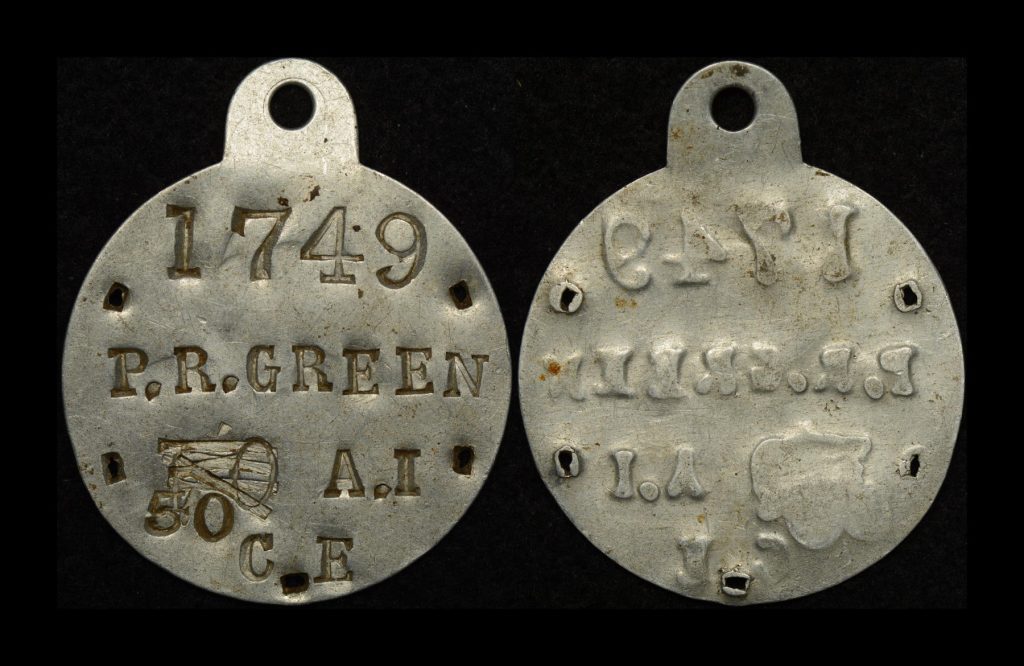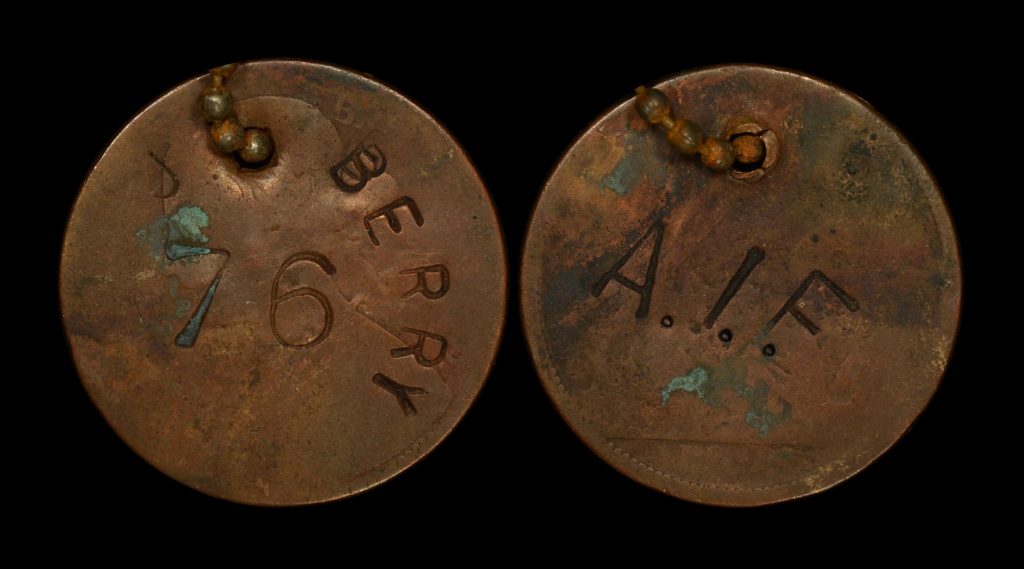Despite being referred to as the “Hobby of Kings” coin collecting often involve the accumulation of what are mostly mundane objects. Every day many coins pass our hands without being looked at, they are worn, damaged, and disposed of without a thought. Coins are, after all, one of the most basic elements of commerce. Despite their mundanity, coins can easily outlive the people that made and handled them by dozens of centuries. Their longevity gives coin collectors a glimpse back into another time and it’s always a romantic notion to consider the people who handled coins that can be found in one’s collection.
The scant regard paid to current coins has often led to their modification or mutilation for a multitude of reasons. These have included creation of gifts, making souvenirs, testing workshop equipment, making jewellery, making identification tags, or even “just because you can” (thinking of coins flattened on railways). Collecting modified coins is not unusual and like most areas of coin collecting there are always opportunities for specialisation. The subject of this article is one such area of specialisation, World War 1 military identity discs made from coins. The authors have further restricted their focus to items created by Australian personnel and ideally the disc should include an Australian service number but this is not a hard and fast requirement.
Coins modified as identification discs give the collector a glimpse into the reasons why the disc was made. In this article we will examine three such discs and postulate the reasons why the soldier made the item.
Identity Discs as Forget-Me-Not Tokens
“Forget-me-not pennies are base metal coins which have been hammered with letter and numeral punches to record a farewell message between two people” [1]
Figure 1 shows an Australian King George V penny that has been silvered and had a loop soldered to the top. The reverse has been skimmed flat and stamped by hand with the following:
FORGET ME NOT
FROM
FRED
WITH FOND LOVE
TO
KITTY
2815
Frederick George Gifford, service number 2815 enlisted in Adelaide in 1916. Gifford served in France in 1917 and 1918 before attending a course in the UK at the Tank Corps Depot. He subsequently shipped back to Australia where he was part of the crew of the British MK IV tank numbered 4643[10]. The tank, eventually named “Grit”, toured Australia in 1918 and 1919 raising money for the war effort and to re-pay war loans. After the tour concluded, the tank was retired to the Australian War Memorial where it is still on display. Gifford’s records include a letter to the Officer Commanding Base Records from one “Miss Kitty C Pantzer” [6].
Lane, in his 2014 JNAA article “South Australian WW1 soldiers’ ‘forget-me-not’ pennies’” describes a peculiarly South Australian example of forget-me-not coins as “base-metal coins which have been hammered with letter and numeral punches to record a farewell message between two people”. The token shown in Figure 1 is an excellent example of the type described by Lane. It’s a token that was not produced by Fred Gifford directly and it was not even produced in France or the UK. It was made in a workshop in suburban Adelaide and given as a gift to Kitty so that she would remember Fred Gifford as he served in Europe.
There is little doubt that this lovely “forget-me-not” token was produced to convey some strong emotion between Fred Gifford and Kitty Pantzer. Research by the authors has not been able to determine exactly what the nature of that relationship was, but it is very likely that this token is the only remaining physical reminder of it.
Identity Discs as Trench Art
“Trench art objects are holders of soldiers’ memories and reminders of the conflict they faced” [5]
It is commonly accepted that soldiers who have faced combat keep mementoes of those times as it provides them with comfort during and after what are, most likely, the most stressful times of their lives [7]. Trench art is one form that these souvenirs often took. Rather inaccurately named [4][5] trench art comprises a range of items not necessarily made “in the trenches” but often made in workshops behind the lines, by soldiers, prisoners of war, or by civilians in areas that soldiers frequented. It was made from virtually any available material such as shell casings, souvenirs taken from enemy soldiers, scrap metal, leather, and of course, coins!
Elaborately engraved coins are beautiful examples of such trench art, moving well beyond merely utilitarian items and becoming a record of one of life’s primary formative experiences, service in an active war zone [11]. Figure 2 shows an Egyptian 50 Piastres of 1917. The obverse has been skimmed neatly inside the rim denticles and then engraved using the ‘wiggle-work’ technique. The inscription reads:
DONOHOE
RC
No 1280
ANZAC
MTD DIVISION
AIF
EGYPT 1916•17•18
The quality of manufacture of this ID disc and the dates suggest it was made deliberately as a souvenir by a skilled craftsman. The span of years allows the owner to gaze on this disc and cast his mind back to his time in army service. Patrick Donohoe enlisted into the AIF in 1915 at Holdsworthy in New South Wales and was given the service number 1280 in No. 5 Squadron, 2nd Remount Unit of the AIF. Examination of his records shows he served in Egypt in the AIF camp in Moascar and in the AIF canteens in the Suez. Interestingly his records are under the surname Donohue (note the variation in spelling) and three separate papers in the records are clearly signed by three different people. Once the surname is spelled “Donohue” and twice “Donohoe”, suggesting that perhaps Donohue may have been illiterate and had others sign his name for him. It is rather enticing to think that when he had this lovely ID disc made that the correct spelling of Donohoe was used despite his official ID discs perhaps saying something different.
Identity Discs as Identity Discs
“Many soldiers have a horror of losing their identification discs, or of being unidentified if they are killed, and buried in a nameless grave” [3]
For the first two years of World War 1 Australian soldiers were only required to wear one ID disc, an aluminium 1907 pattern disc (see Figure 3). The soldier on the frontline saw slaughter and destruction on an “industrial scale” with wide spread use of artillery and machine gun fire that lead to not just death, but often the obliteration of soldier’s bodies. The horror that soldiers had of dying and being unidentified resulted in many wearing ID bracelets, labelling their kit with ID tags, and making impromptu ID discs from coins that were worn about their bodies [2]. These utilitarian ID discs are often crudely manufactured and sometimes follow the form of official ID discs in listing name, service number, unit, and religion. Other times they merely list a name and service number, the bare minimum that a soldier considered necessary to identify them in case the worst was to happen. An unknown author wrote a short piece entitled “Soldier’s Fears” that appeared in many Australian and New Zealand newspapers in 1917 and 1918, and lists the idea of dying unknown and “being buried in a nameless grave” [3] as chief among those fears.
Figure 4 shows what is among the crudest impromptu ID disc made from a coin that the authors have sighted. Crafted from a heavily worn “bunhead” British penny it has been simply made with 9 strikes of letter and numeral punches. It bears just a surname, a service number, and the abbreviation AIF. It is clearly not decorative and thus unlikely to be a souvenir, nor is it addressed to someone. The only purpose can be that of identification and the hole shows that it was intended to be worn.
John Berry enlisted in Melbourne in February 1915 and was taken onto the strength of the 23rd Battalion, 6th Infantry Brigade of the AIF [9]. He was given the service number 76. John arrived in Egypt two days after Christmas in 1915 and just 23 days later was put into hospital with pneumonia. Tragically he died 10 days later. This ID disc hung from a chain along with a white-metal Canterbury Cathedral medallion from the well-known cathedral in Berry’s town of birth in England. The two items are a contradiction, one created to help the man be identified if he meets a most horrible fate in a distant land, the other an embodiment of the hope that he would not suffer that fate and return home safely. Sadly, in the case of John Berry this was not to be.
Conclusions
Coins and the history they contain are a primary motivation for many coin collectors. Military ID discs made from coins are usually not historic or significant coins, in fact, they are often made from worthless coins. However, the simple act of engraving or stamping a coin with some letters or numbers transforms it into a small memorial for a soldier who is long past, and often forgotten. The reasons that soldiers craft coins into ID discs can vary and this can affect the coins they are made from, the level of care they are made with, and the inscriptions they contain. No longer does the collector need to imagine the people whose hands a coin has passed through. With research the they can come to know, in some small way at least, the person who created the ID disc and their motivations for creating it.
References
- Lane, Peter. 2014: South Australian WWI soldiers ‘forget-me-not’ Pennies, JNAA Volume 25, pp 1-15
- Australian War Memorial : Australian identity discs of the First World War [online] Available at: https://www.awm.gov.au/articles/encyclopedia/ww1-identity-discs [Accessed 14 November 2021].
- Soldiers Fears, Maldon News, 2 October 1917, p4. Available at trove.nla.gov.au.
- Imperial War Museum : Trench Art [online] Available at: https://www.iwm.org.uk/history/trench-art [Accessed 14 November 2021].
- National Army Museum : Personal Treasures [online] Available at: https://www.armymuseum.co.nz/whats-on/world-war-one-centenary/personal-treasures-wwi-trench-art/ [Accessed 14 November 2021].
- National Archives of Australia. 2017. Gifford Frederick George : SERN 2815 : POB Exeter SA : POE Adelaide SA : NOK M Gifford Ellen Jane. [ONLINE] Available at: https://recordsearch.naa.gov.au/SearchNRetrieve/Interface/ViewImage.aspx?B=5033507. [Accessed 23 June 2017].
- US Army: Hunting for the Enemy and Souvenirs [online] Available at: https://www.army.mil/article/26504/hunting_for_the_enemy_and_souvenirs [Accessed 4 January 2022].
- National Archives of Australia, Donohue, Patrick : SERN 1280 : POB Galway, Ireland : POE Holdsworthy NSW : NOK Donohue, Dora. [ONLINE] Available at: https://recordsearch.naa.gov.au/SearchNRetrieve/Interface/ViewImage.aspx?B=3514841 [Accessed 15 August 2021]
- National Archives of Australia, Berry, John : SERN 76 : POB Canterbury, England : POE Melbourne, VIC : NOK Berry, Mark. [ONLINE] Available at: https://recordsearch.naa.gov.au/SearchNRetrieve/Interface/ViewImage.aspx?B= 3075840
- Finlayson, D.A., Pioneers of Australian Armour. 1st ed. Big Sky Publishing: Newport, NSW Australia.
- Slade, L., Sappers & Shrapnel. 1st ed. Art Gallery of South Australia: Adelaide, SA Australia.





